From the now defunct Europeanspeed.com
This page is an attempt to rescue the data generated from one of the first B5 S4 chip shoot-outs from August 2000 (coincidentally the same month my S4 was delivered to me from the factory in Germany). The formatting of the page has changed slightly to put all of the data on a single page where the original European Speed article spanned several pages.
Audi S4 Chip Shootout
Important! GIAC chip was re-tested on 8.17.00, dyno chart is here.
If you are here and you are reading this, then you are probably familiar with all of the bulletins and chat rooms on the net about S4 performance chipping. Everybody seems to talk a good game and back it up with sound logic but 99% of the time its just hype. Here at European Speed, we too are tired of reading about how such and such a chip did this or that, so we cut to the chase and literally “paid” a visit to UPRD for their 4wd dyno (yes 4WD dyno!). So with that, European Speed presents to you- the truest and most accurate S4 chip dyno shootout ever!
Selecting Chips and Chip Revelations
In the interesting of chip testing, we attempted to get our grubby little hands on every chip manufacturer we could think of. Unfortunately we did not get responses from a number of tuners (we sent out lots of e-mails) and/or we could not find anyone running their programs, in which we ended up with the most popular chips: (1) APR (2) AMS (3) GIAC (4) MTM.
All of the aftermarket wares used the factory coding as an indication of the software version that was used to design their chip. We noticed that some of the tuners were using an older version than others-, which can be a downgrade in some respects. Another point of interest was whether or not we had the “latest” version of performance software-, which we discovered that MTM and AMS only offered one version while APR and GIAC offered/had updated programs from their original release. As far as we could tell, we had the latest version from each vendor.
The Testing Grounds and Controlled Conditions
This test was conducted at UPRD (Under Pressure Research and Development) in Huntington Beach, California. We have much praise for UPRD’s testing facility and the staff that work there. Friendly, knowledgeable and a clean facility make this operation one of the most professional places we have been to. In addition to their 4WD dyno, they also had a standard dynojet as well as 3 lifts and a number of high tech testing tools. Besides their testing/installation equipment, there were some pretty trick prototype vehicles, which filled the bays… none of which we were allowed to take pictures of- darn!
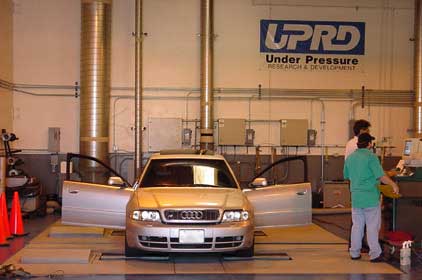
Additional notes:
- 4 WD dyno
- Both Cars tested had the MTM chip previously in the car. To make things as fair as possible the MTM chip was ran last to ensure that any reminisce of the MTM program was removed.
- Test vehicle #1 was completely stock. Test vehicle #2 had a UUC VM1 exhaust.
- Before, during, and after each chip run the intercoolers were sprayed down with water bottles.
- The VW tool was used to adapt the throttle body, check for DTC’s (before and after each chip), record and erase any codes, monitor intake and coolant temperature as well as peak boost and boost at 6500 RPM (test cut-off point).
- A dyno fan used during ALL runs.
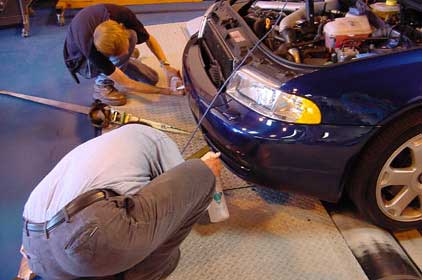
All dyno runs were conducted on the same day using the same dyno with in a period of 4 hours. Each after market chip had the same opportunity to make 2 passes.
First Test Vehicle
2000 S4 in Santorin Blue. This vehicle had approx. 9,500 miles and is a daily driver.
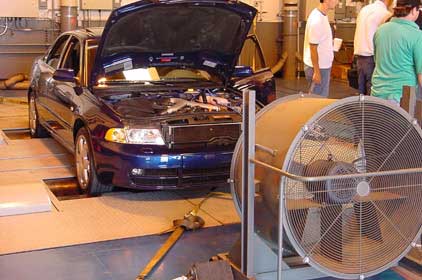
Chip War #1
- Stock Chip (4 runs)
- APR Tiptronic Chip (2 runs)
- AMS Chip (2 runs)
- MTM Chip (2 runs)
- GIAC Chip (did not arrive yet)
The Stock chip
As you can imagine, the stock chip performed flawlessly. We ran this chip 4 times to establish a solid baseline figure. Because the stock chip was so consistent we are not going to report every run. The measured boost levels were extremely steady in comparison to the aftermarket chips, which can be reflected in the smoothness of the dyno.
|
Max Boost |
Boost at 6500 |
Intake Temperature |
Coolant Temperature |
Measured HP |
DTC’s |
|
.64 bar |
.52 bar |
123.8 degrees Fahrenheit |
194 degrees Fahrenheit |
258 |
The APR chip
Following the stock chip was the APR chip. The APR chip used during this run was intended for a tiptronic S4. According to APR, the tiptronic chips are more mild than their standard manual S4 chip. Because this chip was for the tiptronic transmission, it also set off a couple of DTC’s.
Run #1
|
Max Boost |
Boost at 6500 |
Intake Temperature |
Coolant Temperature |
Measured HP |
DTC’s |
|
1.10 bar |
.91 bar |
129.2 degrees Fahrenheit |
203 degrees Fahrenheit |
315 |
Run #2
|
Max Boost |
Boost at 6500 |
Intake Temperature |
Coolant Temperature |
Measured HP |
DTC’s |
|
1.14 bar |
1.1 bar |
123 degrees Fahrenheit |
201 degrees Fahrenheit |
308 |
Data bus powertrain-missing msg from trans controller. |
Cruise control switch in correct signal sporadic
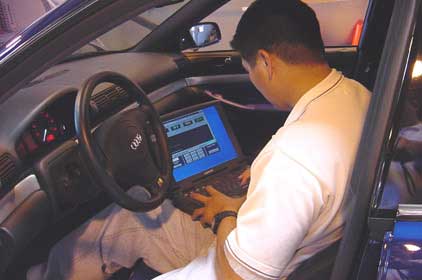
The AMS chip
As a point of clarification, many of the S4 owners were under the impression that ABT and AMS were one in the same- the AMS chip is not an ABT chip, however AMS is the North America Distributor for ABT, which is probably the cause of confusion. Marc Kalajian, owner of AMS, is also the chip programmer.
Run #1
|
Max Boost |
Boost at 6500 |
Intake Temperature |
Coolant Temperature |
Measured HP |
DTC’s |
|
1.23 bar |
1.01 bar |
123.8 degrees Fahrenheit |
194 degrees Fahrenheit |
324 |
Run #2
|
Max Boost |
Boost at 6500 |
Intake Temperature |
Coolant Temperature |
Measured HP |
DTC’s |
|
1.20 |
1.09 |
127.4 degrees Fahrenheit |
203 degrees Fahrenheit |
318 |
The MTM chip [Dyno Chart Link]
The MTM chip is designed and tested in Germany, which is distributed by Joe Hoppen/ Hoppen Motorsports in Florida. Apparently, to get a perfected chip from Germany, they had to send many a version back and forth to get the right combination.
Run #1
|
Max Boost |
Boost at 6500 |
Intake Temperature |
Coolant Temperature |
Measured HP |
DTC’s |
|
1.42 bar |
.910 bar |
125.3 degrees Fahrenheit |
202.4 degrees Fahrenheit |
325 |
Run #2
|
Max Boost |
Boost at 6500 |
Intake Temperature |
Coolant Temperature |
Measured HP |
DTC’s |
|
1.41 bar |
1.00 bar |
125.9 degrees Fahrenheit |
205.8 degrees Fahrenheit |
327 |
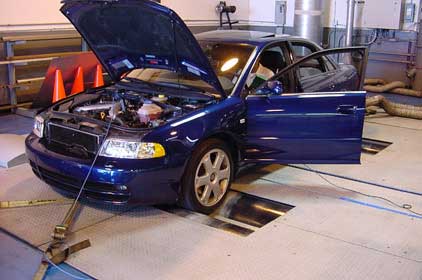
Summary
What we noticed:
1) MTM- huge mid-range and peak hp.
2) AMS- this chip had one of the smoother curves offering solid mid- to upper mid power coming in 2nd for peak hp.
3) APR- good lower mid-range, a little soft in the upper mid RPM’s but not quite as peaky as the other chips. In all fairness, keep in mind that this was a tip-tronic chip.
4) Stock- very smooth and predictable. This chip showed us that heat soak was not much of an issue.
Second Test Vehicle
2000 S4 with UUC VM1 Exhaust

Chip War #2
1. Stock Chip (3 runs)
2. GIAC Chip
3. APR Chip (this chip was for the manual vehicles).
4. AMS Chip
5. MTM Chip
The Stock Chip
Even though this car was running a UUC-VM1 Exhaust unit, the car dynoed about 3 hp more than the first S4 that was completely stock. We only ran 2 baseline tests with the stock chip.
|
Max Boost |
Boost at 6500 |
Intake Temperature |
Coolant Temperature |
Measured HP |
DTC’s |
|
.72 bar |
.63 bar |
156 degrees Fahrenheit |
203 degrees Fahrenheit |
258 |
The GIAC Chip [Dyno Chart Link (faulty chip)] [Re-tested Dyno Chart Link]
In our first session the GIAC Chip was not on hand to be tested. By the time we began our second test vehicle, the GIAC ECU was available. Only one run was conducted with this chip due the audible pinging and the number of faults it triggered. *We had trouble adapting the Throttle Body with this vehicle after the Garrett chip was in place. See DTC’s.
|
Max Boost |
Boost at 6500 |
Intake Temperature |
Coolant Temperature |
Measured HP |
DTC’s |
|
1.10 bar |
.940 bar |
143.6 degrees Fahrenheit |
204.8 degrees Fahrenheit |
281 |
Throttle actuation potentiometer too high. |
Turbo charger boost sensor (a) circuit high input.
Throttle acutation signal too low.
Intake air temp- high input
Engine coolant temperature circulation high output.
The APR Chip
In this session, the standard APR for manual S4’s was used. We used the ECMS to select the “race” program. APR offers a selected chip program using factory switches to select one of three programs offered (stock, performance, and race).
Run #1
|
Max Boost |
Boost at 6500 |
Intake Temperature |
Coolant Temperature |
Measured HP |
DTC’s |
|
1.01 bar |
140 degrees Fahrenheit |
210 degrees Fahrenheit |
313 |
Run #2
|
Max Boost |
Boost at 6500 |
Intake Temperature |
Coolant Temperature |
Measured HP |
DTC’s |
|
* |
* |
* |
* |
310 |
*VW tool lost communication with the ECU during the run.
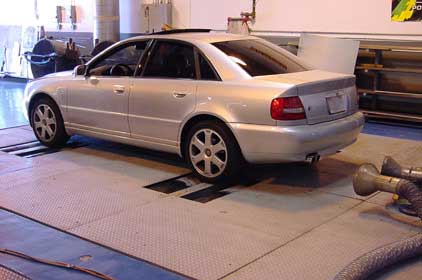
The AMS Chip
Run #1
|
Max Boost |
Boost at 6500 |
Intake Temperature |
Coolant Temperature |
Measured HP |
DTC’s |
|
1.27 bar |
1.0 bar |
123.8 degrees Fahrenheit |
194 degrees Fahrenheit |
318 |
Run #2
|
Max Boost |
Boost at 6500 |
Intake Temperature |
Coolant Temperature |
Measured HP |
DTC’s |
|
1.24 bar |
.95 bar |
123.8 degrees Fahrenheit |
194 degrees Fahrenheit |
315 |
The MTM Chip [Dyno Chart Link]
|
Max Boost |
Boost at 6500 |
Intake Temperature |
Coolant Temperature |
Measured HP |
DTC’s |
|
1.24 bar |
.95 bar |
123.8 degrees Fahrenheit |
194 degrees Fahrenheit |
323 |
Summary
Of the four chips represented here, we found that MTM, AMS, and APR (in that order) would be our chip preference. Unfortunately at this time, we cannot recommend the GIAC chip due to the problems that occurred during this test- perhaps we will get another chance to test this chip? We can only imagine that this was fluke with the GIAC ECU (possibly due to the socketed chip configuration coming loose) as we have met several owners who claim not to have any of the problems we had here and to have easily achieved the performance figures advertised by GIAC.
Overall Conclusion
After running two different cars and the same chips, we definitely found some consistency in performance levels and smoothness of the curves. Most of the chips performed at the claimed levels and then some- which in many cases is a tuning first. We applaud all of the chip tuners for their fine efforts and hope the fierce competition between tuners results in better products for us the consumers.
About The Testing
Surely by the time you read and chat about this article, someone will have suggested a better method or way of testing and or even try to discard the result of our test. We do not proclaim our testing methods as being the holy grail of measurements however we feel that we have significantly cut down the variables, which would have potentially changed the testing results. It would have been nice to drag this test out over a week and mix up the variables, however at a rate of $250 per hour on the dyno and a limited budget this is as good as its going to get. The results presented here are the REAL WORLD results in a tidy package for you the reader to study and help determine on which chip is the best for you. Bottom line is these tests are not only accurate but repeatable.
So the results are official and we have two words for you- CHIP IT!
Audi S4 Chip Shootout
About the Dyno Graphs
More dyno result links can be found at the bottom of this page (as they are uploaded the links will become active).
When looking at the graphs, keep in mind that peak power is only a small perspective. Other points of interest are:
- The peaks and valleys of the curve. Looking at the peaks and valleys represent the power delivery and smoothness (use the stock chip as a baseline for how smooth these peaks and valleys should be). You will also notice that some peaks or spikes sometimes do not truly represent “true” peak hp.
- The curve and shape of the graph. How do you like your power band? Lots of low-end, mid-range, top-end, or a combination of all?
- Look at the graph separations to determine how the aftermarket chip performed against other competitors as well as how it did against stock.
Dyno Results Compared
